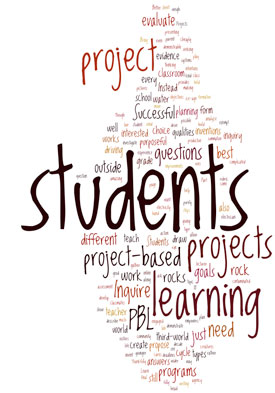
Successful PBL programs create a learning community: The teacher is a learner along with the students. The teacher is still the head of the class and the authority but works as a facilitator rather than a lecturer. PBL programs succeed when they have the following qualities:
Standards-Based
We live in a standards-based world, and PBL programs are not exempt. If you need to teach the rock cycle, it will do no good if students decide that their project is to form a rock band. Instead, you can provide students an inquiry experience that gets them thinking about the rock cycle. You might bring in different types of rocks and have students handle them, draw them, describe them, weigh them, and think about why rocks have different qualities. Then with the students, you can gather driving questions about rocks and how they form, and select a few questions that students can investigate for their projects.
Student-Driven
Student questions should drive the inquiry. You can ask a wonderful driving question, and the students' answers might well be, "Who cares?" But if students pose the questions, they will be much more interested in seeking answers. In the same way, if you allow students some choice in the types of projects they can develop, they will also be more engaged and interested than if they must do only one kind of project. Better yet, have students page through Part III of Inquire and propose the type of project they should do to demonstrate their learning. You can overrule projects that are too easy or too complicated, but giving students choice empowers them.
Hands-On
Successful project-based learning is active. Students don't sit still and listen, but get up and move. They experiment, build, design, draw, analyze, problem-solve, interact, and otherwise fully engage the topic. They propose what they want to do, evaluate what they are doing, and make improvements. There will be some mess and some noise, but it should all be purposeful, building to a productive end.
Rigorous
Successful project-based learning has goals and deadlines just as the professional world does. Students are expected to do their best work on every project and at every stage of the project. Though there is an aspect of play to project-based learning, it is purposeful play—serious in its intentions. Because students assist in writing the goals of a project, they are held accountable to their own expectations. Because students will be presenting their work to a wider audience, they feel the need to do their best.
Authentic
Projects should not be just performances for a grade. They should, whenever possible, connect to life outside the classroom or even outside the school. For example, when teaching about electricity, you might have a parent who is an electrician come in to run a lab. If students are making dioramas of ice-age mammals, you could arrange for them to carry their models to the grade school and teach younger students about these amazing creatures. Instead of having students write an essay about the problem of contaminated water in third-world countries, you might have them invent systems to cheaply and reliably purify water. You could even post pictures of the student inventions online, and have visitors vote for the best solution. If any of the inventions works particularly well, think about sending the plans to a third-world aid agency.
Assessed
Education these days is all about a culture of evidence. You need to show that students are learning content and skills, so projects need both formative and summative assessment. Thankfully, because projects involve multiple steps, each step leaves evidence of learning, and the final project makes the learning demonstrable not just to you and classmates but to those outside of the classroom.